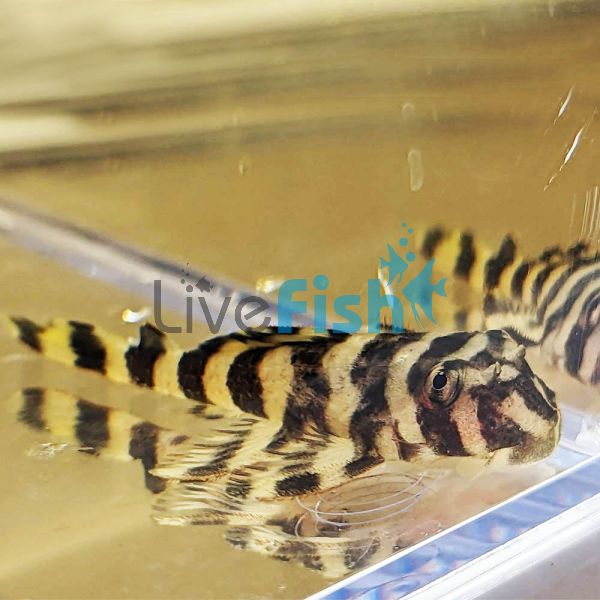Clown Pleco 9cm
L number plecos are a group of fish with a dedicated cult following. There is a sea of different plecos, some of which don’t even have a proper trade name, so they are often given a numerical identification. The L stands for Loricariidae which is the family that plecos are in, the numbers are most likely assigned based on how recently they are discovered with the earlier discovered fish having a smaller number. One real unique and beautiful species is the Clown Pleco or L168. Though L number plecos are more common in other parts of the world, their presence is still growing in Australia, making these fish all the better to own.
Clown Pleco
L number plecos are a group of fish with a dedicated cult following. There is a sea of different plecos, some of which don’t even have a proper trade name, so they are often given a numerical identification. The L stands for Loricariidae which is the family that plecos are in, the numbers are most likely assigned based on how recently they are discovered with the earlier discovered fish having a smaller number. One real unique and beautiful species is the Clown Pleco or L168. Though L number plecos are more common in other parts of the world, their presence is still growing in Australia, making these fish all the better to own.
The clown pleco is easily recognised by its colouration. These have a yellow and black striped patterning that runs from head to tail much like a bumblebee. Why these fish are called clown plecos instead of bumblebee plecos is a great question but regardless they look fantastic. As juveniles the barring is very well split however as the fish mature the patterning does blend slightly with the yellow darkening to a browner tone as well. One different thing about these plecos is how much more vertically compressed these plecos are compared to other species. This is likely an adaptation due to the fast-flowing waters these fish are from, by being flatter and more streamlined they can cling to rocks and wood much better. For an aquarist who has had some experience keeping and breeding bristlenose plecos and is chasing a new breeding project or a slightly more challenging species then these plecos would be the perfect option. They offer a slight variation in care and primarily diet as they do not solely rely on wood or plant matter for feeding. Clown plecos will be a great fish in a species-only breeding tank or even a community aquarium where you might only see them ever so often but their inclusiveness certainly makes them such a satisfying fish to see every now and then.
Clown plecos can be slightly more challenging to breed in captivity compared to the more common bristlenose but it isn’t too bad. The main thing is that these fish can take a while to reach maturity. The most ideal way of breeding these fish would be to put them in a dedicated, species-only aquarium (the only exception being small tetras to act as dither fish) and an abundance of pleco caves to entice breeding. By providing a plentiful supply of food, doing regular water changes, and not entering with the tank setting too much can get these fish breeding.
Tank Recommendations for your Clown Pleco
Clown plecos can be kept alone and will need an aquarium with a minimum of 70 litres. This ensures that there is room for other tank mates whilst also giving this pleco, which can reach around 13cm the space it needs. To look at having a successful breeding colony it would be best to keep them in a larger aquarium with at least 6 individuals. A sand or gravel substrate is perfectly fine but most importantly they will love hiding areas around small pieces of driftwood, and rock caves and they will love a densely planted aquarium as well. This species is mostly active when lights are turned off.
Suitable Tank Buddies
The clown pleco is extremely peaceful with aggression only ever coming out with breeding males breeding however this is 9.5 times out of 10, very harmless. With adequate space, these fish will get along with a wide range of community fish.
Usually Compatible
Tetras, gouramis, corydoras, angelfish, barbs dwarf cichlids such as rams, and large peaceful cichlids such as uaru or Severums.
Sometime Compatible
Semi-aggressive or territorial cichlids like jack Dempseys, fire mouths, convicts cichlids, and similar species.
Rarely Compatible
Large aggressive species such as African cichlids, Oscars, and Jaguar cichlids. These species may try to eat the clown pleco which could end in death for both fish. Because of the dense bone and armour plating the plecos often get lodged in the predator fish’s throat.
Feeding your Clown Pleco
Clown plecos are by no means a hard species to feed and will easily thrive on a quality sinking pleco wafer that has a decent protein content. Ensuring that you are getting a quality pleco wafer is important as poor-quality options can quickly foul the water and offer little nutritional value for the fish. They will however also feed on wood although minimal but their diet can be supplemented with blanched veggies like zucchini and pumpkin.
| Scientific Name | Dekeyseria pulchra |
|---|---|
| Care Level | Moderate |
| Common Names | L168 Pleco, Clown Pleco, Butterfly Clown Pleco |
| Diet | Omnivore |
| Fish Family | Loricariidae |
| Lifespan (years) | 10 |
| Max. Length (cm) | 13 |
| Min. Tank Volume (l) | 70 |
| Origin | South America |
| Reef Safe | Yes |
| Sociability | Peaceful |
| Venomous | No |
| Water Conditions | 24-28° C, pH 5.0-7.0 |




